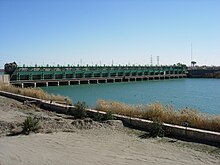Ramadi Barrage
| Ramadi Barrage | |
|---|---|
 Upstream face of southern barrage, facing southeast | |
 Location of Ramadi Barrage in Iraq | |
| Location | Directly west of Ramadi, Al Anbar Governorate, Iraq |
| Coordinates | 33°26′04″N 43°15′55″E / 33.43444°N 43.26528°E / 33.43444; 43.26528Coordinates: 33°26′04″N 43°15′55″E / 33.43444°N 43.26528°E / 33.43444; 43.26528 |
| Opening date | 1955 |
| Operator(s) | Ministry of Water Resources |
| Dam and spillways | |
| Impounds | Euphrates River |
Ramadi Barrage is a two-section diversion dam on the Euphrates River adjacent (west) of Ramadi, Iraq. The main purpose of the northern barrage is to slow or stop water if needed, allowing it to be diverted through the southern barrage into a canal. The canal feeds water into Lake Habbaniyah to the southeast.[1]
The intent was to use water stored by the Ramadi Barrage and the Samarra Barrage for irrigation. However, evaporation on Lakes Habbaniyah and Tharthar led to reduced storage and high salinity, conditions unsuitable for irrigation.[2]
References
^ "Iraqi Dam Assessments" (PDF). Iraq: United States Army, Corps of Engineers. 6 June 2003. Archived from the original (PDF) on 24 September 2015. Retrieved 27 February 2012..mw-parser-output cite.citation{font-style:inherit}.mw-parser-output q{quotes:"""""""'""'"}.mw-parser-output code.cs1-code{color:inherit;background:inherit;border:inherit;padding:inherit}.mw-parser-output .cs1-lock-free a{background:url("//upload.wikimedia.org/wikipedia/commons/thumb/6/65/Lock-green.svg/9px-Lock-green.svg.png")no-repeat;background-position:right .1em center}.mw-parser-output .cs1-lock-limited a,.mw-parser-output .cs1-lock-registration a{background:url("//upload.wikimedia.org/wikipedia/commons/thumb/d/d6/Lock-gray-alt-2.svg/9px-Lock-gray-alt-2.svg.png")no-repeat;background-position:right .1em center}.mw-parser-output .cs1-lock-subscription a{background:url("//upload.wikimedia.org/wikipedia/commons/thumb/a/aa/Lock-red-alt-2.svg/9px-Lock-red-alt-2.svg.png")no-repeat;background-position:right .1em center}.mw-parser-output .cs1-subscription,.mw-parser-output .cs1-registration{color:#555}.mw-parser-output .cs1-subscription span,.mw-parser-output .cs1-registration span{border-bottom:1px dotted;cursor:help}.mw-parser-output .cs1-hidden-error{display:none;font-size:100%}.mw-parser-output .cs1-visible-error{font-size:100%}.mw-parser-output .cs1-subscription,.mw-parser-output .cs1-registration,.mw-parser-output .cs1-format{font-size:95%}.mw-parser-output .cs1-kern-left,.mw-parser-output .cs1-kern-wl-left{padding-left:0.2em}.mw-parser-output .cs1-kern-right,.mw-parser-output .cs1-kern-wl-right{padding-right:0.2em}
^ "Managing Water For Peace: The Tigris and Euphrates Rivers". United Nations University. Retrieved 27 February 2012.
| Wikimedia Commons has media related to Ramadi Barrage. |